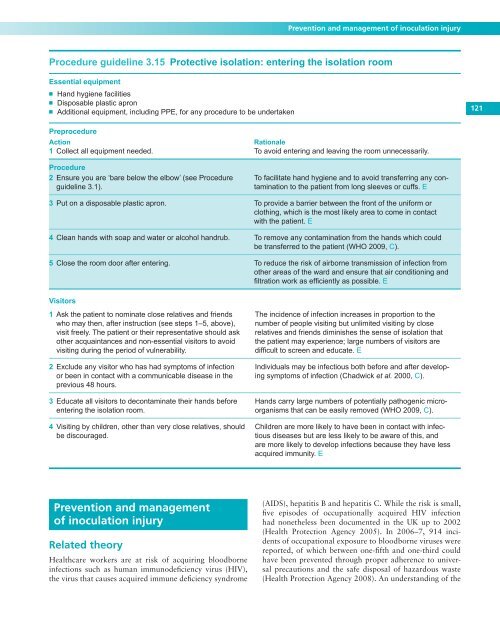Infection prevention and control - Royal Marsden Manual of Clinical ...
Infection prevention and control - Royal Marsden Manual of Clinical ...
Infection prevention and control - Royal Marsden Manual of Clinical ...
Create successful ePaper yourself
Turn your PDF publications into a flip-book with our unique Google optimized e-Paper software.
Prevention <strong>and</strong> management <strong>of</strong> inoculation injury<br />
Procedure guideline 3.15 Protective isolation: entering the isolation room<br />
Essential equipment<br />
■ H<strong>and</strong> hygiene facilities<br />
■ Disposable plastic apron<br />
■ Additional equipment, including PPE, for any procedure to be undertaken<br />
Preprocedure<br />
Action Rationale<br />
1 Collect all equipment needed. To avoid entering <strong>and</strong> leaving the room unnecessarily.<br />
Procedure<br />
2 Ensure you are ‘bare below the elbow’ (see Procedure<br />
guideline 3.1 ).<br />
To facilitate h<strong>and</strong> hygiene <strong>and</strong> to avoid transferring any contamination<br />
to the patient from long sleeves or cuffs. E<br />
3 Put on a disposable plastic apron. To provide a barrier between the front <strong>of</strong> the uniform or<br />
clothing, which is the most likely area to come in contact<br />
with the patient. E<br />
4 Clean h<strong>and</strong>s with soap <strong>and</strong> water or alcohol h<strong>and</strong>rub. To remove any contamination from the h<strong>and</strong>s which could<br />
be transferred to the patient ( WHO 2009 , C ).<br />
5 Close the room door after entering. To reduce the risk <strong>of</strong> airborne transmission <strong>of</strong> infection from<br />
other areas <strong>of</strong> the ward <strong>and</strong> ensure that air conditioning <strong>and</strong><br />
fi ltration work as effi ciently as possible. E<br />
Visitors<br />
1 Ask the patient to nominate close relatives <strong>and</strong> friends<br />
who may then, after instruction (see steps 1–5, above),<br />
visit freely. The patient or their representative should ask<br />
other acquaintances <strong>and</strong> non-essential visitors to avoid<br />
visiting during the period <strong>of</strong> vulnerability.<br />
2 Exclude any visitor who has had symptoms <strong>of</strong> infection<br />
or been in contact with a communicable disease in the<br />
previous 48 hours.<br />
3 Educate all visitors to decontaminate their h<strong>and</strong>s before<br />
entering the isolation room.<br />
4 Visiting by children, other than very close relatives, should<br />
be discouraged.<br />
Prevention <strong>and</strong> management<br />
<strong>of</strong> inoculation injury<br />
Related theory<br />
Healthcare workers are at risk <strong>of</strong> acquiring bloodborne<br />
infections such as human immunodefi ciency virus (HIV),<br />
the virus that causes acquired immune defi ciency syndrome<br />
The incidence <strong>of</strong> infection increases in proportion to the<br />
number <strong>of</strong> people visiting but unlimited visiting by close<br />
relatives <strong>and</strong> friends diminishes the sense <strong>of</strong> isolation that<br />
the patient may experience; large numbers <strong>of</strong> visitors are<br />
diffi cult to screen <strong>and</strong> educate. E<br />
Individuals may be infectious both before <strong>and</strong> after developing<br />
symptoms <strong>of</strong> infection ( Chadwick et al. 2000, C ).<br />
H<strong>and</strong>s carry large numbers <strong>of</strong> potentially pathogenic microorganisms<br />
that can be easily removed ( WHO 2009, C ).<br />
Children are more likely to have been in contact with infectious<br />
diseases but are less likely to be aware <strong>of</strong> this, <strong>and</strong><br />
are more likely to develop infections because they have less<br />
acquired immunity. E<br />
(AIDS), hepatitis B <strong>and</strong> hepatitis C. While the risk is small,<br />
fi ve episodes <strong>of</strong> occupationally acquired HIV infection<br />
had nonetheless been documented in the UK up to 2002<br />
( Health Protection Agency 2005 ). In 2006–7, 914 incidents<br />
<strong>of</strong> occupational exposure to bloodborne viruses were<br />
reported, <strong>of</strong> which between one-fi fth <strong>and</strong> one-third could<br />
have been prevented through proper adherence to universal<br />
precautions <strong>and</strong> the safe disposal <strong>of</strong> hazardous waste<br />
( Health Protection Agency 2008 ). An underst<strong>and</strong>ing <strong>of</strong> the<br />
121


